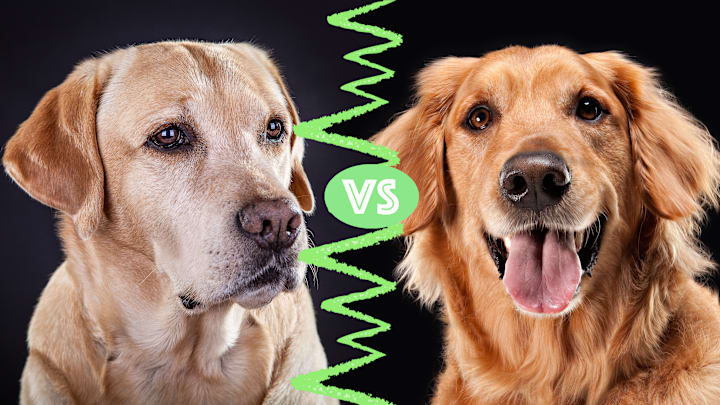Labradors and golden retrievers are enough alike to get mistaken for each other fairly often, but they’re not impossible to tell apart once you know what to look for. Here’s a guide to the similarities and differences between these dogs—and how other retriever breeds fit in.
- Labradors and Goldens: Similarities
- Yellow Labrador vs. Golden Retriever
- Golden Labrador vs. Golden Retriever
- The Chesapeake Bay Retriever and Other Retriever Breeds
Labradors and Goldens: Similarities
Labrador retrievers and golden retrievers are both, well, retrievers. Historically, they were hunting dogs that located fallen game and brought it to the hunters. (Some still do.) Both breeds are known for being friendly, gentle, trainable, and sociable with humans and other dogs—which makes them a popular pet for families. They also both shed quite a lot, and their size and lifespan ranges are almost identical.
Breed | Height | Weight | Life Expectancy |
|---|---|---|---|
Labrador retrievers | 21.5 to 24.5 inches | 55 to 80 pounds | 11 to 13 years |
Golden retrievers | 21.5 to 24 inches | 55 to 75 pounds | 10 to 12 years |
Yellow Labrador vs. Golden Retriever

There is some overlap in the coat colors of Labradors and golden retrievers. Labs, as breeder Dr. Frances Smith told the American Kennel Club (AKC), “can shed hair in three colors—yellow (ranging from pale cream to fox red), black, and chocolate.” Goldens’ coats, meanwhile, can only be “from very pale cream to nearly fox red.”
So you can’t always be sure you’re looking at a yellow Labrador or a golden retriever based on color alone. But coat length can help: Labs’ hair is typically shorter, while the hair on goldens is often longer and feathered along the edges. Their faces and body shapes are a little different, too—Labrador retrievers have shorter muzzles and ears than their golden counterparts, and their build is a little stockier.
Breed | Coat Colors | Coat Length | Facial Traits | Body Type |
|---|---|---|---|---|
Labrador retrievers | Yellow (cream to copper), black, or chocolate | On the shorter side | Shorter muzzle and ears | Stockier with a rounder rib cage |
Golden retrievers | Pale cream to light copper | Longer with some feathering along the edges | Longer muzzle and ears | On the slimmer side |
Golden Labrador vs. Golden Retriever

Though people sometimes use the term golden Labrador to describe a lab with a relatively dark yellow coat, that’s not technically correct. And it can even make it unclear what kind of dog you’re talking about, because golden Labrador is also used to describe a mix between a Labrador and a golden. The best way to mitigate confusion is probably just to call those dogs “goldadors.”
As labs and goldens are so similar to begin with, it’s unsurprising that their crossbreed is pretty close to each purebreed. But that’s not to say all goldadors are gold: They can have any combination of their parents’ visual characteristics, so some goldadors end up with chocolate or black coats. In short, if you see a dog with the face of a golden retriever but the dark chocolate coloring of a lab, there’s a fairly good chance that it’s a goldador.
The Chesapeake Bay Retriever and Other Retriever Breeds
Labs and goldens aren’t the only two types of retrievers: The AKC recognizes six breeds in total.

The Chesapeake Bay retriever, known for its wavy brown, waterproof coat and stellar swimming skills, has a particularly interesting origin story. In 1807, a ship en route from Newfoundland to England wrecked off the Maryland coast, and the two St. John’s water dogs (a now extinct breed) aboard were rescued and sold separately to two families in the Chesapeake Bay region. Each was bred with various other dogs in the area to create the “Chessie.”
There’s also the curly-coated retriever, which may include Newfoundlands, poodles, and Irish water spaniels in its breeding history; the flat-coated retriever, whose flat coat and long head helps distinguish it from other retrievers; and the Nova Scotia duck tolling retriever, or “toller,” a smaller retriever whose playful behavior helps attract ducks to the shoreline (where hunters can more easily target them). Toll in the Middle Ages meant “to attract, entice,” per the Oxford English Dictionary, and by the 19th century people had started using it specifically to describe attracting wild animals for capture.
Curly-coated and flat-coated retrievers both have black or liver coats, while tollers are reddish or copper-colored.

Discover the Differences Between Other Animals:
